subbuteo
France v. Scotland – Full Match Video
I had some time this week to play a few games and for one of them, I recorded the action. I think it gives a decent idea of how the game can be played.
The 1st Half:
The 2nd Half:
Principles of Play – Subbuteo Rugby My Way
INTRODUCTION
Subbuteo Rugby is a challenging table-top replica of rugby. The game can replicate either Union or League when appropriate variations to playing procedures are applied. In this document, I focus exclusively on Rugby Union. A second document that focuses on League is forthcoming.
My objective with this document, or guide, is to explain how I play Subbuteo Rugby using a combination of the original Subbuteo Rugby rules of play, modifications made by members of the Italian rugby-playing community, the real Laws of Rugby, and my own subsequent modifications. This is a personal approach which I enjoy. It is my intent to pass along my experiences to others with an interest in playing, either as starters or as long-standing participants, so that we may share ideas and information and get as much enjoyment as possible from this excellent pass-time.
I have organised the guide to demonstrate the key elements of the main phases of rugby play. Each phase is linked to a tutorial video that is available on my YouTube channel.
GENERAL PRINCIPLES OF PLAY
The game is played under the auspices of the real Laws of the Game. As such, actions, events and their consequences link directly to those stated in the Laws. However, the technicalities of the Laws and the difficulties of playing mauls and rucks, for instance, means that many playing principles in the real game are not replicated by Subbuteo. Or at least, for now. Part of the development of Subbuteo play is to find innovations that bring the game even closer to the real experience.
Nonetheless, the primary objective of Subbuteo Rugby is the same as real rugby– for one team to score more points than their opponent. To do this, the team carrying the ball must legally move it into the opponents’ in-goal or kick successfully through the goal posts.
To do this in Subbuteo requires that the playing figures of the attacking and defending teams are moved around in a reasonably realistic way. The team in possession has an unlimited number of touches of the ball until they lose possession. Subbuteo’s original rules recommend that for every touch of the ball made by the attacking side, the defending side gets one (1) defensive flick to block the progression of the attackers but without touching the ball or otherwise interfering with play. This works best when the game is played by 2 players (humans) but for solo play it becomes a little cumbersome.
At this point I will highlight the first major modification to the original rules that I have introduced to my play. I give 3 flicks to the player on the attacking team that has possession before giving 1 flick to the defending team. I find this allows the attacking team to properly get the ball under control while preventing defending players from “crowding” the ball carrier. The defending figures now have to be moved more strategically to block the attacker. In addition, the attacking team can also make more ground before any defending pressure can be applied, thereby recreating the real experience of the attackers being on the front foot and the defenders being on the back foot. Overall, I find this makes for a faster game.
With this in mind, let’s look at each of the structural elements of Subbuteo Rugby.
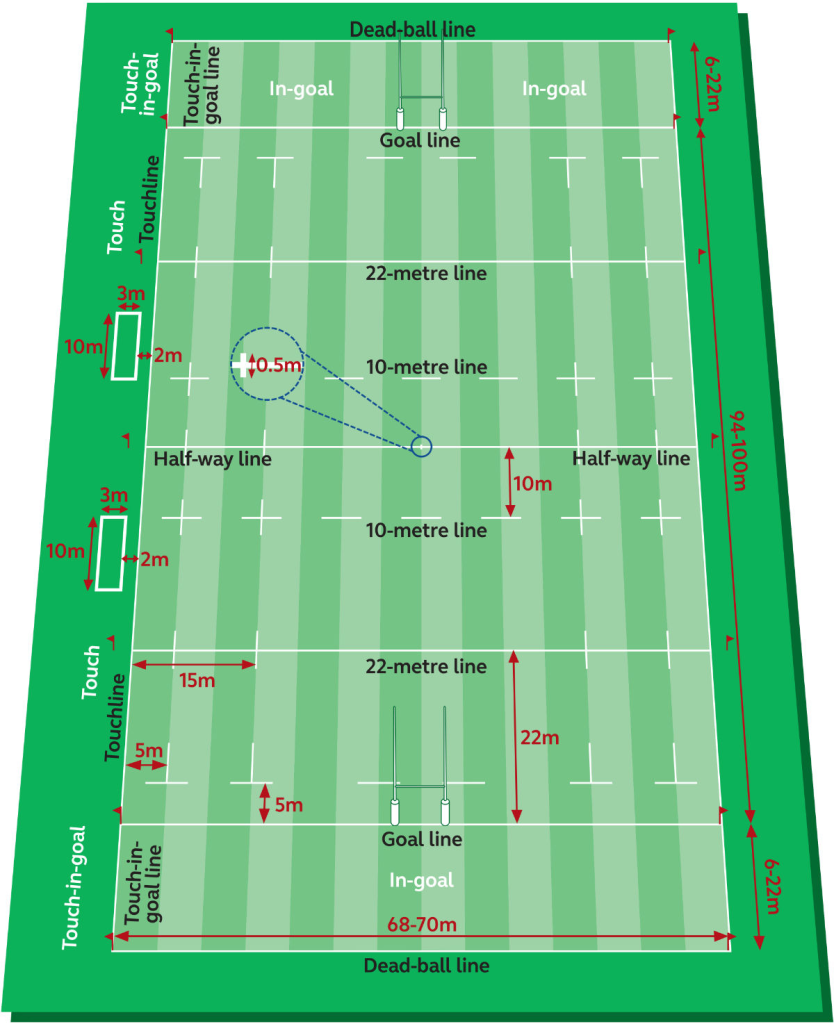
Source: https://www.world.rugby/the-game/laws/law/1
DURATION & TIME-KEEPING
The game has 2 halves, each of which lasts for 20 minutes. The clock is stopped to allow for players to be moved for setting up scrums and line-outs, and repositioning associated with penalties and restarts. Each half ends as it does in real rugby, with play continuing into the red-zone (ie. after the final official minute has ended) until play is dead – see Law 5.
KICK-OFF & RESTARTS
Each half starts with a kick-off taken from the centre spot at mid-field. Kick-offs also restart the game after a score. This may be performed by the kicking figure or by using the kicking wedge. The choice is yours.
The kick-off is legal when the ball remains within the field of play and has travelled across the 10m line. A kick that lands between the 10m line and the 22m line without being touched by the receiving team is still in possession of the kicking team who may flick a figure to the ball. They keep possession if they touch the ball; if they do not, the receiving team may attempt to touch the ball with one of their figures. Should they miss then the kicking team may try again.
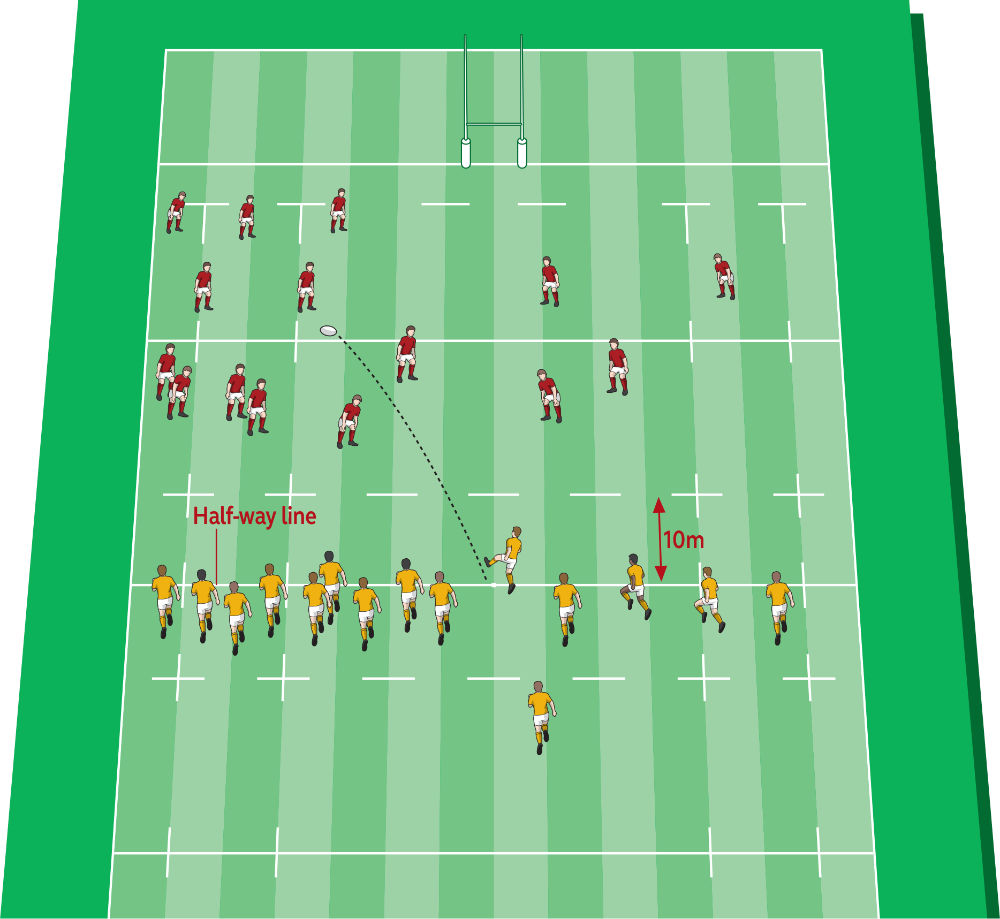
Source: https://www.world.rugby/the-game/laws/law/12
A ball kicked across the the 22m becomes the possession of the receiving team and they can bring it out as they see fit. If they fail to touch the ball with their flick the kicking team may attempt to gain possession by flicking one of their figures to touch the ball.
When the kick-off fails to travel across the10m line, or goes through the in-goal or goes directly into touch, the receiving team has the option to allow a re-kick, take a scrum at the centre spot, or take a line-out. The choice is entirely dependent on the advantage offered to the receiving team and their overall strategy. For example, a kick-off that crosses the touchline deep in the 22m zone could be accepted as a line-out to the receiving team. However, this would put them at a disadvantage and a scrum on the centre spot would give better field position.
KICK TO GAIN GROUND
Kicks to gain ground, either to move the ball forward out of the defensive zone or to move the ball quickly into an attacking area (the old up-and-under) are performed using the kicking wedge. To be legal, the closest defending player must be more than 2.5cm (long-side of kicking wedge) away from the ball in the direction of the kick. Call ‘kick” put the wedge in position and flick/kick away. Playing figures from either side may be moved by flicking, either to cover the kick or to come back from offside positions. No limit on flicks for this procedure.
Other kicks, either drop-outs from the 22, or from the goal-line, if the ball has gone dead in the in-goal, area all governed by the real Laws (Law 12 and Law 21).
PASSING & POSSSESSION
As previously stated, the attacking side gains possession by initially touching the ball. The total number of touches is unlimited until possession ends. While in possession, I allow 3 touches to control and move the ball forward before the defending side can make a covering flick. I continue this 3-to-1 ratio throughout the period of possession. The ball must remain within 2.5cm of the ball carrier in order for possession to be maintained.
However, an exception I play is that if a touch of the ball sends it beyond 2.5cm, the carrier is still considered to be in possession but must touch the ball with the next flick. If this happens, ball and figure must keep within the 2.5cm limit. If not, or the ball is missed, then a knock-on may be called. If the defending team feel they can attack from this point, they can carry-on. If they do so, then they are doing so under the Penalty Advantage rule (Law 7), meaning that if they end up not gaining anything from the advantage call, play may be halted and the defending team receive a scrum at the point where the original knock-on occurred (who said rugby was simple!).
Passes may be made at any time. A pass is a flick against the ball that sends it backwards or parallel to an imaginary line that is perpendicular to the touch-line. If the ball goes towards the opponents goal then it is a forward pass and is penalised accordingly (Law 11).
A player may also “hand-off “a ball to a team-mate. For me this means that the ball is legally to the side of the ball carrier when one of his team-mates from behind is flicked to the ball to move it forward. This replicates what we often see in the real game where a full-back, for example, sprints from the back and “bursts” through the defensive line.
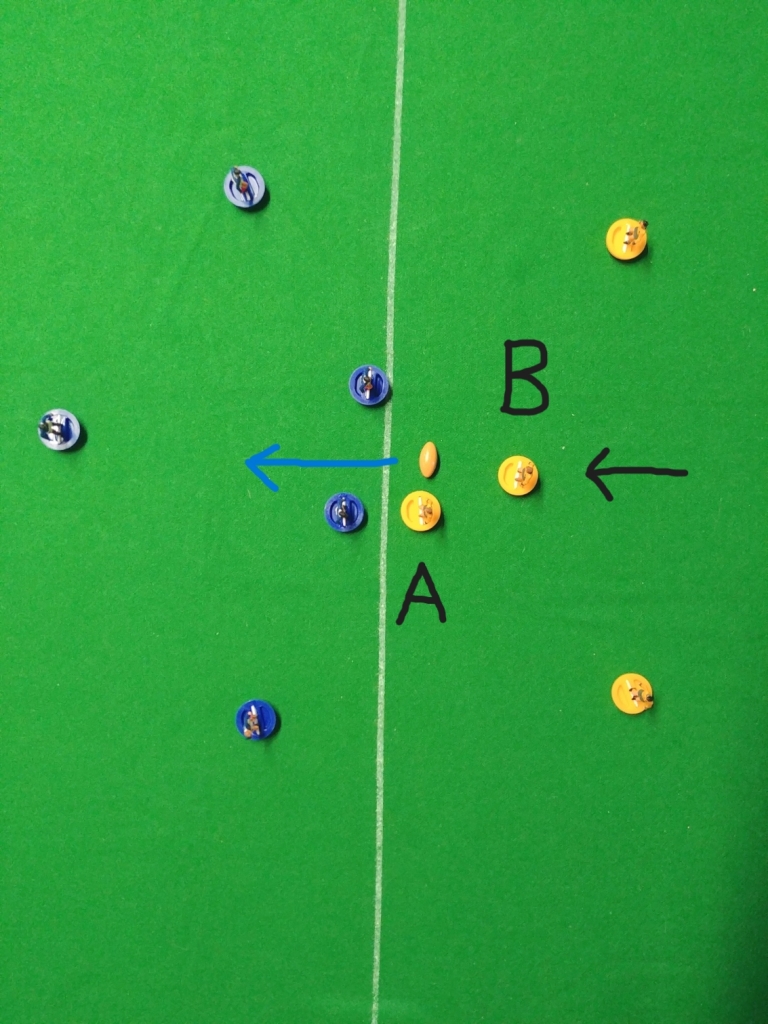
At times, however, the attacker becomes “surrounded” by defenders. To escape such situations, the attacker can call “Pass”. When called, each side may take up to 5 positioning flicks and the defenders around the attacker are moved back 1cm to free space for the attacker’s pass. The attacking team continues their possession when a legal pass is performed.
TACKLING
Tackling always seemed to me to be one of the most confusing aspects of Subbuteo Rugby – when is a tackle not a tackle and why does a Subbuteo “tackle” look nothing like the real thing? Well, to be fair, we have to reconfigure our minds to accept how Subbuteo tackling works. Basically it represents a change-over of possession when the attacking team flicks the ball against an opponent, thereby losing possession just like in Subbuteo Football.
“Tackles” and subsequent turnovers are also made when the attacking team fails to touch the ball and the defending team then makes a touch and claims possession.
ATTACKING & SCORING
The purpose of the game is to score. Law 8 specifies the points scored for tries, conversions and kicks.
A try is scored by legally moving the ball forward to get into the in-goal, or to touch the goal-line. The attacking player who puts the ball in either of these positions must then touch the ball and keep it within the 2.5cm limit to score. If the flick is too strong and the ball travels more than 2.5cm, then a try is not scored and a knock-on is ruled, with a scrum to the defending team.
When a try is scored, the attacking team attempts a conversion kick. The kick is taken from a position as described by Law 8: “on a line through the place where the try was awarded, parallel to the touch-line.”
A drop goal may be attempted at any time. The attacker calls “Drop” and then may attempt the kick using the kicking wedge. However, the drop attempt is only allowed if all defending players are more than 2.5 cm from the ball at the time of the call for a drop. Scoring is per Law 8, and a miss requires a restart described in Law 21.
SCRUM
Scrums are awarded to restart the game for various reasons. Although I consider the “Scrum Machine” a clever and innovative way to include this aspect of rugby into the Subbuteo version, I prefer the method adopted by the Italian Subbuteo community. It just seems more aligned with the game and less gimmicky or “toyish”.
As per the video description players are arranged in the 3-4-1 formation either side of the mark and the put-in is made by the scrum-half. Possession is determined by which team the ball touches or is closest to after the put-in, and play continues with the respective scrum half taking possession or passing from behind the No. 8 (the 1 in the 3-4-1).
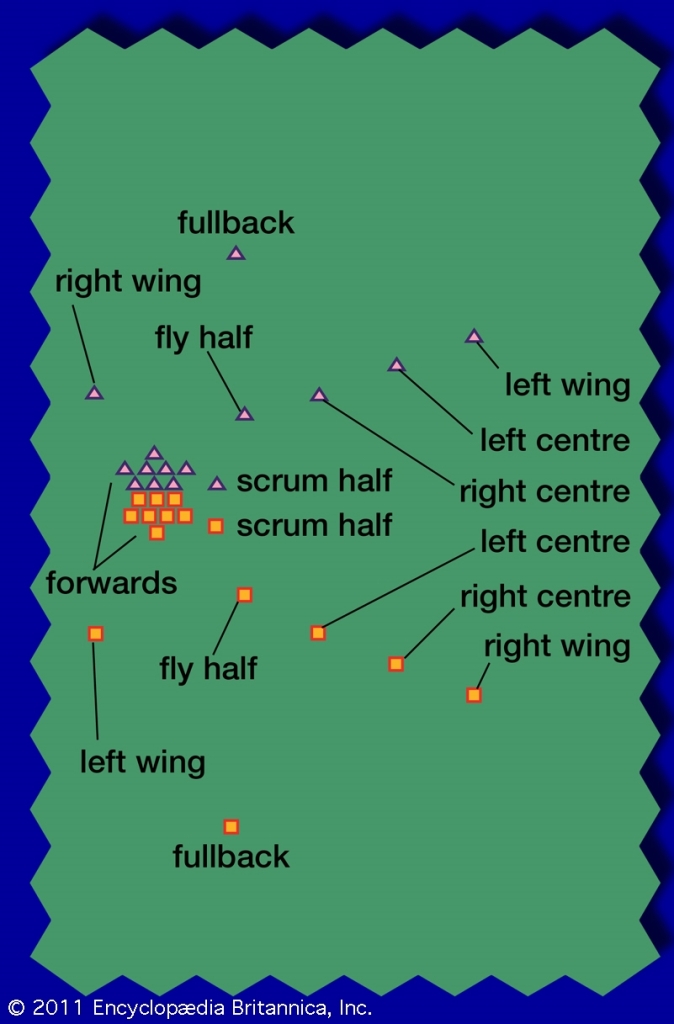
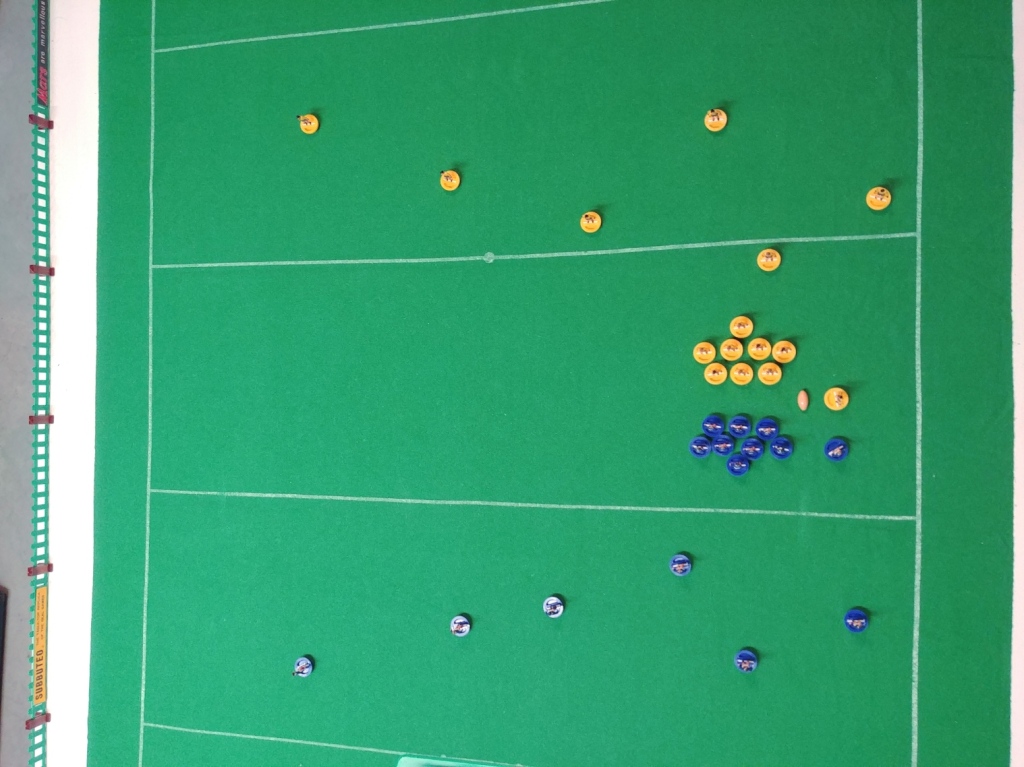
If desired, once the scrum is completed, up to 5 players from each side may be flicked away from the scrum. I find this a little time consuming for solo play, although I do sometimes apply this option.
LINE-OUT
The line-out is also a way to re-start the game but applies only to balls that have crossed the touch-line. Players are arranged per the video. The team winning possession from the throw is the one touched by the ball or closest to it. Play continues from behind the player touched or closest to the ball.
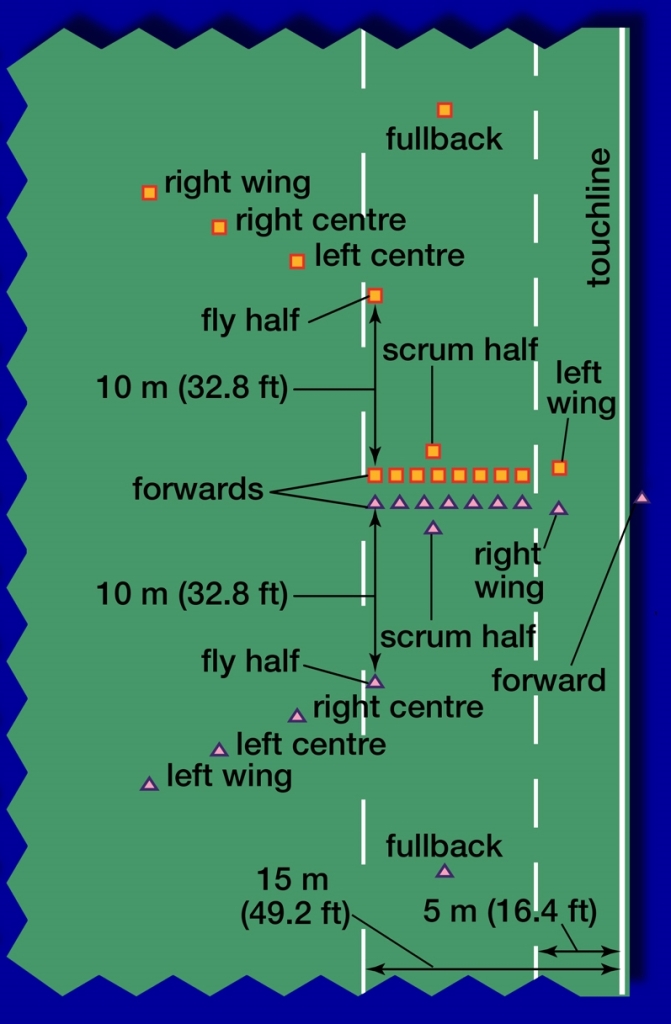

Again, this is a modification from Subbuteo’s original rules which required the ball to be “thrown” by placing the ball on the thrower’s base and manually throwing the ball. Either approach works; it’s up to you.
If desired, and similar to the end of scrums, an option to apply repositioning flicks for up to 3 players is available.
OFFSIDES & FOULS
Real rugby has a number of very technical rules which create frequent penalty decisions during the course of game. Many of these situations cannot be replicated in Subbuteo Rugby. But some can and here’s how I include them.
a) Offside
Any players from the same team who are closer to their opponent’s goal than the ball are offside and must be flicked and re-positioned as soon as possible. Should the ball touch an offside player after a flick by a team-mate, a penalty is awarded.
b) Fouls
A penalty is awarded when:
- an attacking support player hits a defender;
- a defender flicked to block hits an opponent including the ball carrier.
A “Back”, which is the replacement of an offending player to its original starting position, is awarded when a defending player is flicked and touches the ball but not the opponent.
c) Obstruction
Obstruction is when a player is between the ball and an opponent, preventing the opponent from having a direct flick at the ball. This is called “Static Obstruction” and offending players are to be flicked aside without conceding a blocking flick.
Deliberate obstruction is when a player is deliberately flicked between the ball and an opponent, preventing a direct flick at the ball. This is not allowed and is a penalty.
(Note: in older versions of the Subbuteo rules, this was allowed and required the attacking team to “spin” their player around the defender to the ball. For me, this slowed the game down too much and created an unrealistic number of turnovers).
As with defending players, attacking players must not be used as blockers for the ball carrier – this is Crossing and results in a penalty.
CONCLUSION
Subbuteo Rugby is a challenging game that, with some thought and a great deal of sharing of ideas, provides an excellent recreation of the real game. My journey has crossed many paths and I have used my experiences to develop a series of tutorials about the main elements and phases of the game. Rather than rules, we have principles of play, principles that I hope help players learn and develop their games. Play on!
SUBBUTEO TABLE RUGBY & ME

Christmas Day, 1971. A large gift with my name on it wrapped and under the tree. Now don’t tell my parents but I knew what it was; I’d snooped in their bedroom a few days before and found it on top of the wardrobe. “To David. From Mum and Dad” was written on the tag. That morning, I ripped the paper off and there it was. I was already an avid (too avid, according to my mum) Subbuteo Soccer player: leagues, cups, teams, lists; all of it). And now, staring back at me, officially mind and no longer secretively from the top of the wardrobe, Subbuteo Rugby International Edition.
And so it began. Well sort of. I sorted out how to play the game. I knew a bit about rugby from my dad. He followed English Rugby League and we watched televised games from time to time. Rugby Union wasn’t of the same interest and it was the rules of rugby league that dominated my education. For me, Subbuteo Rugby was played that way. But only off and on. The novelty of the kicker and the scrum machine and the “chunky” players remained secondary to my soccer. Yet, despite changing countries and moving half-way around the world, letting Subbuteo Rugby go in the pre-move clear-out wasn’t on. It stayed in a box, along with the soccer and cricket, untouched and unmoved for more years than I care to comment on.
But it was always there, in a box, until one day I decided to take a look at what I still had and there it was hidden away. Unfair, I thought. Let’s at least get this displayed somehow. Out it came and onto a shelf to sit again untouched for a few more years.
Then “Hello Covid” and we’re all inside thinking about ways to occupy ourselves. Switch on the internet, read a few things until eventually “Is there anything happening with Subbuteo?” And that’s where it began again. Lots of folk playing soccer again and a few videos on YouTube (Dr. Pako, Davide Rigone) and Subbuteo Rugby groups on Facebook. But how the heck do you play this game? I’d been out of touch for so long. I occasionally watched the real game on TV but it seemed a different animal to what I knew when I played at school. And how was the real game really reflected by Subbuteo Rugby.

But off I went on a journey, combining the ideas of Facebook contributors and the fellows from YouTube mentioned above, the real Laws of the Game, the rules published elsewhere on this web site and, even the rules provided in the Subbuteo box. One final ingredient – artistic license, my own modifications to create a fast-moving and challenging game.

I’d done it. I’d re-discovered Subbuteo Rugby! And what a find. Now I play, I paint teams, I take photographs and I even make videos, including tutorials on how I play and hopefully others are encouraged to join in. In my next, post I will direct you to the videos which, I hope, show just how enjoyable Subbuteo Rugby really is.